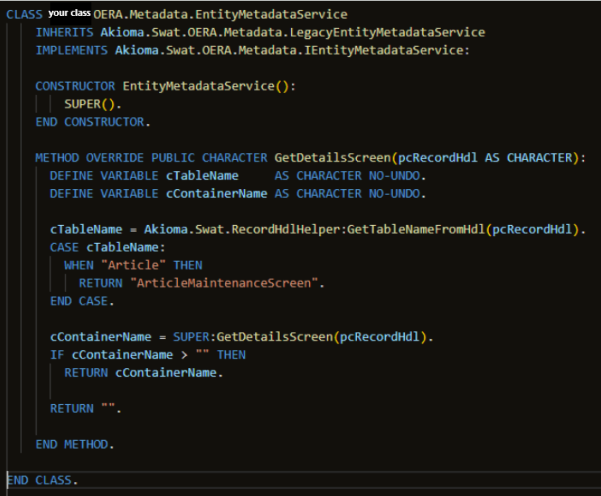...
First, set the 'MruTableNames' application setting (comma-separated list) to include the table name(s) for which you want to register a new entity.
This can be done in SWAT either in the (config→ environment -> .restapplicationsettings file,)
Or from the Application Settings Desktop (from UI, if available).
...
Customers would need to provide their own implementation of this service (either by implementing the service from scratch or overriding the default SWAT legacy implementation). Create a folder in src → backend which is called <Customer Name > create a folder <OERA> create folder <metadata> and file EntityMetadataService.cls and insert the following code and overwrite the table name.
| Expand | |||||
|---|---|---|---|---|---|
| |||||
|
Declaration
You also need to specify which implementation of the service will be used:
IEntityMetadataService customization:
| Expand | ||
|---|---|---|
| ||
|
IEntityMetadataService customization
The following methods can be customized from RecordHdlHelper through the service:
| RecordHdlHelper Method | IEntityMetadataService Method | Description |
|---|---|---|
| GetKeyFieldOfTableId | GetKeyFieldById | |
| GetKeyFieldOfTableName | GetKeyFieldByName | |
| GetTableNameFromId | GetNameById | |
| GetInternalKeyOfTable | GetInternalKeyFieldByName | |
GetTableIdFromName | GetIdByName | |
GetDescFieldsOfTable | GetDescriptionFieldsByName | |
GetOwnerOfTable | GetProductByName | |
IsTransField | IsTransField | |
GetForeignTablePropertiesOfField | GetLinkedEntityPropertiesOfField | |
GetForeignTableNameOfField | GetLinkedEntityOfField | |
GetContainerOfHdl | GetDetailsScreen | Used for MRU details container |
GetLabelOfHdl | GetLabel | Used for MRU Label |
GetIconOfHdl | GetIcon | Used for MRU Icon |
Table Definition
Some fields used in the template get their value based on the table definition file
(for ex. TargetKey is set based on the xml table KeyFields attribute; so at runtime, for our table, the value display for the MRU entry keycomes from the field specified in the attribute).
This applies for the key (KeyFields attribute) and the MRU record description (descriptionFields attribute).
For SWAT and for POCs, the table definition file needs to be included in pasoe-config.xml, under the tableDefinitionsDumpFile property:
Repository Object Changes
...
In order to launch the screen (in our case, profilew articlemaintenancescreen) by clicking on a grid column, you need to do the following steps:
- In the source grid, on the column you click on, set the following attributes:
- SUBTYPE: LAUNCH
- VisualizationType: LINK
- KeyField: *key field of the table* (in our case, selfHdl)
- On the grid itself, set the following attribute
- FolderWindowToLaunch: *detail screen to open on click* (in our case, profileWarticlemaintenancescreen) - used to specify which screen opens on click;
...
- Finally, on the DSO used in the details screen, set the EventAfterFetch to the following: '$ akioma.registerMruEntryFromBE(self);'.
This will call a function in the MruBT.cls which will do the registering in the MRU table. The data source needs its index to point to a valid record in order for the register to work.
The details screen should have the same PrimarySDO as the DSO used in the grid (dzuserArticleDSO).
After those steps are followed, the new MRU entities will show up in the MRU Data View.
Once you double-click on an item, it will open the screen specified above.
IMPORTANT: Double-clicking on an item from the MRU data View will only work if the data Source has one of the following fields: selfhdl, refhdl or childhdl.













